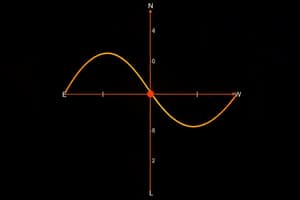Podcast
Questions and Answers
What was the key innovation in Cayley's aircraft design that distinguished it from earlier attempts at flight?
What was the key innovation in Cayley's aircraft design that distinguished it from earlier attempts at flight?
- The elimination of a tail for stability.
- The use of flapping wings to generate both lift and propulsion.
- The integration of lift and propulsion as separate functions. (correct)
- The exclusive reliance on steam power for thrust.
How did Cayley address the issue of achieving both lightness and strength in his aircraft designs?
How did Cayley address the issue of achieving both lightness and strength in his aircraft designs?
- By theorizing on aerodynamics which takes into account the necessity of both lightness and strength. (correct)
- By ignoring the problem, focusing solely on aerodynamic principles.
- By using heavier materials in the wings to withstand bending movements.
- By using solid metal components for maximum durability.
Cayley's Coin illustrates what fundamental concept related to aerodynamic forces?
Cayley's Coin illustrates what fundamental concept related to aerodynamic forces?
- The four main forces of flight (lift, thrust, weight, drag) and their interdependence (correct)
- The exclusive role of thrust in overcoming drag.
- The primary importance of weight reduction in achieving flight.
- The concept of streamlining.
Which statement describes the relationship between lift and weight in the context of flight, as understood by Cayley?
Which statement describes the relationship between lift and weight in the context of flight, as understood by Cayley?
What aerodynamic principle, crucial for flight, did Cayley introduce, relating to the shape of the wing?
What aerodynamic principle, crucial for flight, did Cayley introduce, relating to the shape of the wing?
What key insight did Sir George Cayley contribute to the understanding of flight?
What key insight did Sir George Cayley contribute to the understanding of flight?
What was John Stringfellow's primary technical challenge in his aircraft development efforts?
What was John Stringfellow's primary technical challenge in his aircraft development efforts?
The Aerial Steam Transit Company, proposed by Henson and Stringfellow, aimed to:
The Aerial Steam Transit Company, proposed by Henson and Stringfellow, aimed to:
Stringfellow's 1848 experiment is significant in the history of aviation because:
Stringfellow's 1848 experiment is significant in the history of aviation because:
What distinguishes Henson and Stringfellow's contributions to aviation despite their failures?
What distinguishes Henson and Stringfellow's contributions to aviation despite their failures?
Alphonse Pénaud's experiments in aviation are notable for:
Alphonse Pénaud's experiments in aviation are notable for:
Why is Alphonse Pénaud considered a significant figure in 19th-century aeronautics, despite his tragic end?
Why is Alphonse Pénaud considered a significant figure in 19th-century aeronautics, despite his tragic end?
Otto Lilienthal's early interest in aviation was sparked by:
Otto Lilienthal's early interest in aviation was sparked by:
Lilienthal's book, Birdflight as the Basis of Aviation, is important because:
Lilienthal's book, Birdflight as the Basis of Aviation, is important because:
What critical limitation led to Otto Lilienthal's fatal crash?
What critical limitation led to Otto Lilienthal's fatal crash?
Despite his misconception about flapping wings, Lilienthal is considered a great aviation pioneer. Why?
Despite his misconception about flapping wings, Lilienthal is considered a great aviation pioneer. Why?
Octave Chanute contributed to aviation primarily through:
Octave Chanute contributed to aviation primarily through:
Chanute proposed controlling gliders by moving the wings, contrasting with Lilienthal's method of:
Chanute proposed controlling gliders by moving the wings, contrasting with Lilienthal's method of:
What was the significance of Wilbur Wright's 1900 letter to Octave Chanute?
What was the significance of Wilbur Wright's 1900 letter to Octave Chanute?
Chanute considered the Wright brothers' success as fulfilling his own aspirations in aviation because:
Chanute considered the Wright brothers' success as fulfilling his own aspirations in aviation because:
Flashcards
George Cayley's Theories
George Cayley's Theories
Theorized on aerodynamics, velocity, wing loads, bending movements and the necessity for lightness and strength.
Cayley's Key Aerodynamic Concepts
Cayley's Key Aerodynamic Concepts
Combining lightness and strength, streamlining, and cambered wings are necessary for flight.
Cayley's Airplane Design (1799)
Cayley's Airplane Design (1799)
Cayley's 1799 design featured a fixed wing, separate propulsion, and stabilizing tail.
Lift and Propulsion Separation
Lift and Propulsion Separation
Signup and view all the flashcards
Cambered Wing
Cambered Wing
Signup and view all the flashcards
Sir George Cayley's Insight
Sir George Cayley's Insight
Signup and view all the flashcards
John Stringfellow's Challenge
John Stringfellow's Challenge
Signup and view all the flashcards
William Henson's Design
William Henson's Design
Signup and view all the flashcards
Aerial Steam Transit Company
Aerial Steam Transit Company
Signup and view all the flashcards
Stringfellow's Engine
Stringfellow's Engine
Signup and view all the flashcards
Stringfellow's 1848 Flight
Stringfellow's 1848 Flight
Signup and view all the flashcards
Henson's Aerial Carriage
Henson's Aerial Carriage
Signup and view all the flashcards
Alphonse Penaud's Invention
Alphonse Penaud's Invention
Signup and view all the flashcards
Lilienthal's Wing Discovery
Lilienthal's Wing Discovery
Signup and view all the flashcards
Birdflight as the Basis of Aviation
Birdflight as the Basis of Aviation
Signup and view all the flashcards
Otto Lilienthal's Impact
Otto Lilienthal's Impact
Signup and view all the flashcards
Lilienthal's Gliding Legacy
Lilienthal's Gliding Legacy
Signup and view all the flashcards
Chanute's Glider Control
Chanute's Glider Control
Signup and view all the flashcards
Chanute's Engineering
Chanute's Engineering
Signup and view all the flashcards
Chanute's Influence on Wright Brothers
Chanute's Influence on Wright Brothers
Signup and view all the flashcards
Study Notes
George Cayley
- Theorized on aerodynamics problems, addressing velocity, wing loads, bending movements, and combining lightness with strength.
- Foresaw the need for streamlining.
- Realized a cambered or curved wing was necessary for flight, not a flat wing.
- Known as the Father of Aerodynamics.
Cayley Coin
- In 1799, Sir George Cayley (1773-1857) designed an airplane featuring a fixed wing, separate propulsion, and stabilizing tail.
- Broke lift and propulsion into two separate parts.
- Understood wings couldn't generate power by flapping.
- Envisioned an independent power source and introduced the concept of camber.
- Engraved his design on a coin, known as Cayley's Coin.
- One side of the coin showed a picture of his flying machine.
- The other side had a diagram of four forces of flight: lift, weight, drag, and thrust.
- Thrust and drag work in opposition.
- Lift and weight work in opposition.
- Understood an object remains in the air only when lift, weight, drag, and thrust are balanced
William Henson and John Stringfellow
- John Stringfellow's challenge was building a light steam engine for aircraft.
- William Henson, was an engineer with a patent for an improved steam engine.
- Henson designed a single-wing airplane, against Cayley's multi-wing advice.
- Henson and Stringfellow sold stock in their company to raise funds.
- The company aimed to build and operate flying machines.
- They wanted to launch the Aerial Steam Transit Company in 1843, an international airline.
- Stringfellow built a steam engine and a new model airplane with 10-foot wingspan.
- Some historians regard it as the first practical engine capable of successful performance.
- In 1848, a glider with their engine became airborne, flying 120 feet in a test; no one was aboard.
- Henson and Stringfellow were never able to construct a successful full sized airplane to be flown.
- Henson's design was logically conceived and his aerial carriage was a plausible expression of what an airplane should be.
- Even though the tests with the models were unsatisfactory, they were nonetheless, a serious attempt to fly a propeller-driven, engine powered airplane.
- George Cayley was influenced by this machine
Alphonse Penaud
- Brilliant airplane experimenter in France preceding the Wright Brothers
- Applied marine engineering training to aeronautics.
- In 1870, discovered the twisted rubber band as a power source for model airplanes.
- His workable helicopter model spurred mass production of rubber band driven toys.
- In 1876, he patented his design which was far ahead of its time.
- He committed suicide at 30 due to frustration and criticism of his work.
- Experiments including the Wright Brothers would rank Penaud close to Cayley as one of the most significant 19th century aeronautical thinkers
Otto Lilienthal
- Father of glider experiments, German engineer
- Noticed storks took off against the wind.
- His brother wrote "rising against the wind might be easier than with the wing"
- Recognized the superiority of a curved wing over the flat type.
- He wrote the book Birdflight as the Basis of Aviation in 1889
- He crashed because his machine was unstable and controllable only by human strength and agility.
- Instability and controllability only by human strength and agility were not adequate for successful sustained flight, nor could they readily be incorporated in a practical flying machine
- His greatest contributions was arousing interest in others who continued the advancement of man's effort to develop the airplane
- Performed a great deal of research into the problems of flying.
- Proved superiority of curved over flat wings
- He was able to find real answers by actually flying
- Brought the art of gliding to an everyday accepted fact
- Regarded as one of the greatest pioneers of aviation
- He believed that flapping wings were the answer to aerial locomotion which was one misconception
- On August 9, 1896 a sudden gust of wind tossed him upward at a sharp increase which he could not recover and plunged to the ground ultimately breaking his spine
Octave Chanute
- Learned successful civil engineer
- His approach to flight was scientific.
- President of the American Society of Civil Engineers, constructed the Union Stock Yards in Chicago.
- Aeronautics was a hobby until his middle sixties.
- Prior activities involved gathering and writing information.
- Published "Progress in Aviation" in 1894, discussing aviation history.
- Lilienthal controlled gliders by shifting weight, Chanute proposed a weight based mechanism for control by moving the wings
- Introduced civil engineering concepts (strut and diagonal wire bracing) to airplane building.
- He was convinced experiments with gliders would lead to stable controllable aircraft that could be driven by an engine
- Published findings in the Journal of Western Society of Engineers, inviting further experimentation.
- In 1900 no one accepted the invitation until Wilbur Wright inquired about construction, materials, and experiments, mentioning he could think of no better way to spend his vacation.
- Chanute was happy to comply with Wilbur's request and this was the beginning of a long relation with the Wright brothers
- Chanute was present when the Wright brothers were experimenting with their gliders at Kitty Hawk, North Carolina in 1903
- Felt as a proud father to the Wright Brothers' experiments.
- Remained interested in their efforts until death in 1910.
- Gave the Wright brothers guidance and inspiration
- They made true to his belief that the goal of useful airplanes could be reached
Samuel P. Langley
- Mathematician, astronomer, and physicist.
- In 1889, Langley went to the Smithsonian Institution as its secretary.
- Began publishing aerodynamic findings and was recognized as a leading authority in aviation.
- Wilbur Wright said that Langley's knowledge and position as the the head of such a scientific Institutions was an influence which further led the Wright Brothers to investigate the possibility of flying
- He directed his experiments using all kinds of engines such as:
- Hot Air
- Compressed Air
- Gas
- Electricity
- Carbonic Acid
- Gunpowder
- He needed a lightweight, high-powered engine before he could launch a successful airplane.
- He directed a program to perfect a steam engine because he decided steam had the greatest possibilities.
- October 7, 1903 in the book it mentions that Charles Manly, a Cornell University graduate and Langley had a machine did not fly and it plunged in to the Potomac River
Studying That Suits You
Use AI to generate personalized quizzes and flashcards to suit your learning preferences.




